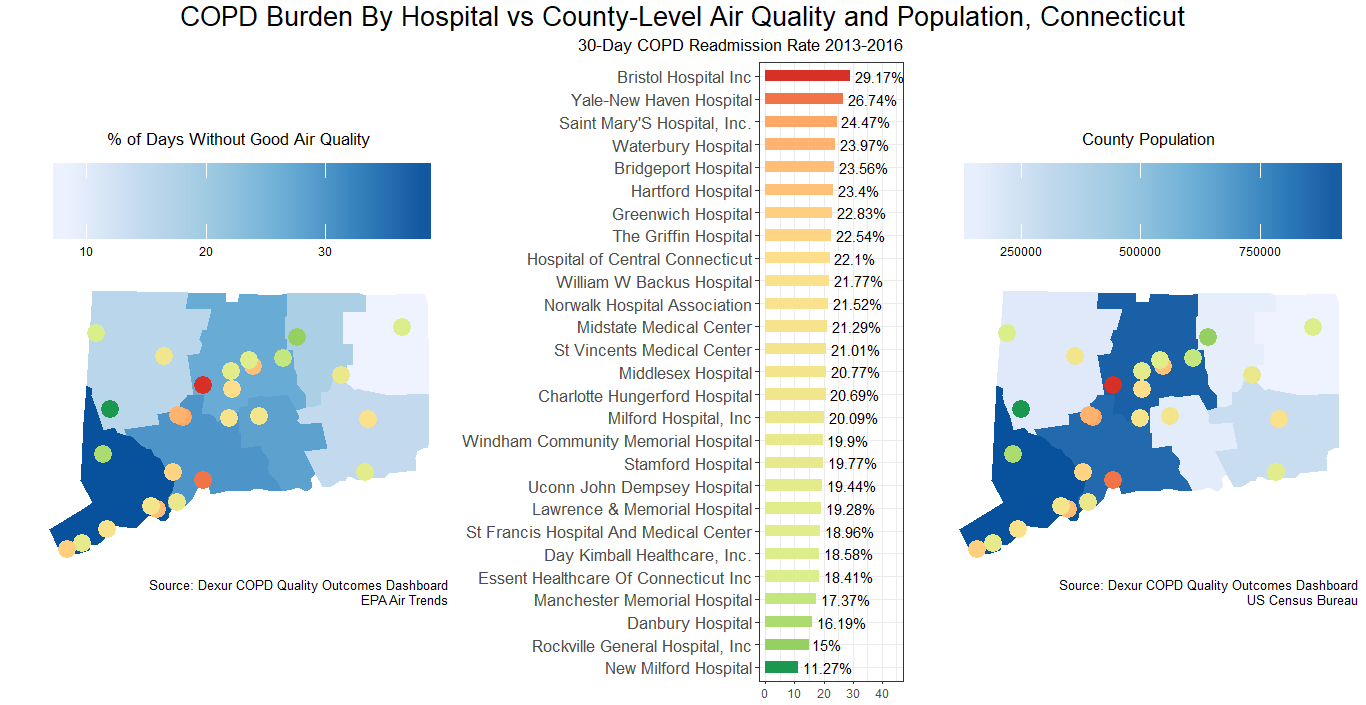COPD Readmission Rates Correlate More Strongly with Population than Air Quality at County Level in Connecticut
In Chronic Obstructive Pulmonary Disease (COPD)
Get Dexur’s Personalized Hospital Specific Presentation on Quality, Safety, Compliance & Education
By: James Pitt Jul. 02, 2018
Chronic obstructive pulmonary disorder (COPD) is a common lung disorder involving reduced airflow. Dexur has previously examined the relationship between air pollution and COPD in Oklahoma, a state with little air quality monitoring at county level. Connecticut, however, has monitors in each of its eight counties. Dexur has previously investigated length of stay among COPD patients in Connecticut. Here, analysts examined the relationship between air quality and 30-day COPD readmissions rate, a measure of disease burden.

The EPA classifies air quality by levels of health concern. Median air quality index (AQI) in a county correlated weakly with the 30-day COPD readmission rates of hospitals in that county (Pearson's correlation 0.299). The percent of days without good air quality, when the county's air quality was classified as “moderate” or lower, had a slightly stronger correlation (0.327) with COPD readmission rates at hospitals in that county.
The highest 30-day COPD readmission rate was 29.17% at Bristol Hospital (Bristol, CT). The lowest was 11.27% at New Milford Hospital (New Milford, CT).
County-level population had a notably stronger correlation with COPD readmission rates than county-level air quality did, at an 0.458 correlation between population and 30-day COPD readmission rates. This may indicate air quality monitoring with too little detail to reflect the full burden of air pollution around industrial and urban centers. Or, it may reflect other population-density-associated risk factors of COPD. A 2016 study in Australia found that traffic density was a strong predictor of COPD risk, and a 2007 study in California found that zip-code-level variations in COPD reflected socioeconomic status and smoking rates. Dexur will continue to investigate predictors of COPD at county level.
DEXUR PRO MEMBERS GET ACCESS TO:
- Total Discharges ( Jan 2013 to Dec 2016 )
- Total Discharges After Exclusion
- All Cause 30 Day Readmissions
- 30 Day COPD Readmissions
- 30 Day COPD Readmission Rate
- State 30 Day COPD Readmission Rate
- National 30 Day COPD Readmission Rate
- % 30 Day Readmissions back to Same Hospital
- 30 to 60 Day COPD Readmissions
- 30 to 60 Day COPD Readmission Rate
- State 30 to 60 Day COPD Readmission Rate
- National 30 to 60 Day COPD Readmission Rate
At DRG level, for COPD overall, DRG 190, DRG 191, and DRG 192, from 2013-2016, for the following hospitals:
- Yale-New Haven Hospital
- Hartford Hospital
- St Francis Hospital And Medical Center
- Danbury Hospital
- Bridgeport Hospital
- Middlesex Hospital
- St Vincents Medical Center
- Lawrence & Memorial Hospital
- Norwalk Hospital Association
- Stamford Hospital
- Hospital Of Central Connecticut
- Saint Mary's Hospital, Inc
- William W Backus Hospital
- Waterbury Hospital
- Greenwich Hospital
- Uconn John Dempsey Hospital
- Midstate Medical Center
- Charlotte Hungerford Hospital
- The Griffin Hospital
- Manchester Memorial Hospital
- Bristol Hospital Inc
- Day Kimball Healthcare, Inc
- Milford Hospital, Inc
- Essent Healthcare Of Connecticut Inc
- Windham Community Memorial Hospital
- Rockville General Hospital, Inc
- New Milford Hospital
ABOUT THE AUTHOR
